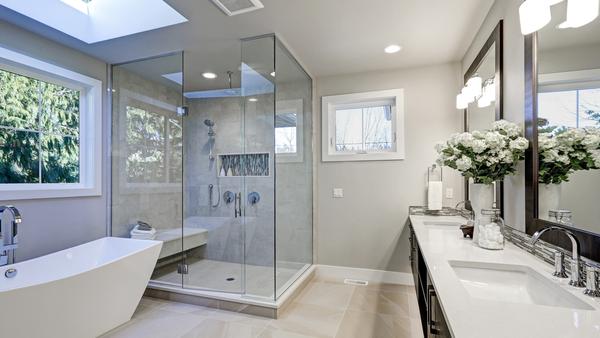Designing a bathroom involves lots of considerations, so the experts here at Halmshaws have put together these design tips and ideas which you should keep in mind when planning your dream bathroom! Discover the best layouts, bath features and effective storage solutions.
1. Vanity
When designing your bathroom layout you will need to consider the position and the size of the vanity. The vanity must be large enough to cater for your needs, there must be enough space to move around the bathroom and swinging doors must not interfere with the vanity.
If you have a small bathroom or if you like an open space, a floating vanity can visually expand the appearance of your bathroom. Floating vanities are often required if your bathroom has in-floor heating.
If you are renovating your bathroom, it is recommended to position your vanity in accordance with the rest of the plumbing in your bathroom otherwise you will need to pay extra to have the plumbing diverted.
2. Cabinets
Depending on the size of your bathroom and your personal needs, you can choose from a host of options whether it be a double-sink vanity, a wall mounted cabinet or storage shelves. When selecting your cabinetry it is important to incorporate form and function into the theme you want to make – for example traditional, modern, retro or vintage etc.
Much like kitchen cabinets, you can purchase bathroom cabinetry in stock units or you can cabinet’s custom designed and built. Depending on your budget, stock units are typically least expensive and custom designed and built the most expensive. When choosing the material of your cabinetry it is important to select products that are water resistant and heat resistant to ensure longevity of the cabinetry.
3. Shower
Consider building an open-concept shower that does not require a door or curtains, this will allow the bathroom to appear spacious. It is particularly important to ensure sufficient drainage in the shower if there is no shower door or curtain.
An inbuilt shelf in the shower wall is a great way to store products rather than on the floor of the shower. In addition, a shower head mounted on the roof or high on the shower wall will prevent water from splashing outside the shower.
4. Bathtub
If your bathroom is large enough to include a bathtub, you can use this as a feature point of the bathroom. Freestanding bathtubs are ideal if you do not have a very large bathroom or if you want to position the bath in the centre of the room.
Freestanding bathtubs can be mounted onto the floor, rest on a pedestal base or on claw-and-bull feet. On the other hand, you may choose an inbuilt bathtub whereby the bath is built into a box-like structure. If you choose this option, you may decide to use a feature material on the surroundings of the bath to make it the feature of the bathroom.
5. Toilet
When designing the bathroom, toilet placement is very important as the toilet must not only pass regulations but must also be comfortable for the users. The toilet should always be out of view from people sitting in dining areas, kitchens or living rooms.
If you have a relatively small bathroom, it is important to make sure that the swing of the door when entering the bathroom does not interfere with the location of the toilet. If the swinging door does interfere, consider installing a sliding door. Alternatively, you may consider having the toilet in its own compartment.
The removal of odour must also be considered when designing the toilet. Placing a vent fan in the ceiling, in the centre of the bathroom or the toilet compartment is the most effective method to remove odour. Alternatively, small high windows above the toilet are another option.
6. Visit Our Showrooms
Still not sure where to start with your new bathroom? Visit one of our showrooms in Beverley or Hull, where our expert team will be happy to guide you every step of the way.





